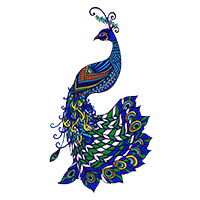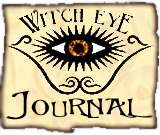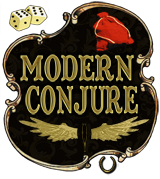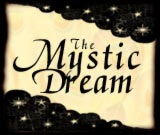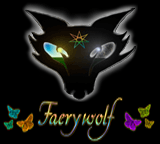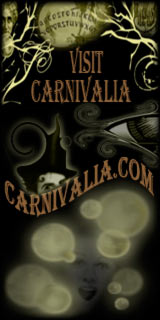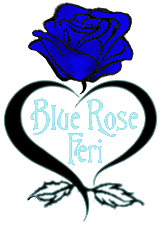Phoenix Willow says:
Victor taught that that Feri was a religion/magical science dating back to a primordial "small slender dark people" who came out of Africa many thousands of years ago. These are the original "fairies" and they turn up in the legends of many cultures under different names.
What's the history of Feri? What are some of the lineages?
Victor Anderson: Started creating the Feri trad more-or-less as we know it in the 1940s. He began initiating people on an individual basis into the tradition before the 1950's. According to Cora, Victor received a letter in 1960 [other accounts say it was a phone call] from several witches in Italy, among them Leo Martello, asking him to form a coven in California.
Gwydion Pendderwen/Watchmaker:During the 1950's and 60's, Victor's Craft "foster-son," Gwydion Pendderwen (Tom deLong) worked with him, and helped to edit and publish Victor's book, Thorns of the Blood Rose.
Gwydion emphasized Celtic origins almost exclusively in his own practice, with a smattering of Voudoun; other teachers have emphasized the Hawaiian, the African-diaspora, or even traced the lineage back to the Attacotti, who were small dark possibly southern European settlers in Scotland thousands of years ago.
Gwydion later moved north to Annwfn (Witch-owned land in Mendocino county), and worked psychedelic group shamanic and Voudon rituals. Gwydion produced a large number of articles, rituals, poems, and songs before his death in 1982. There is a line of Feri descended from Gwydion, known as Watchmaker. Not much is known about this line, as its practitioners are quite reclusive.
Vanthi: The late Alison Harlow, initiated by Victor Anderson and Gwydion Pendderwen in the early 1970s, brought in a taste of Gardnerianism to her coven/lineage, Vanthi. She was made 3rd degree Gardnerian many years after her Feri initiation and training. Some descendants of Vanthi still teach as a coven. Other descendants teach as individuals. Some of the Vanthi line lore is quite different from the lines of Feri that descend from the Bloodrose line. --J'te, August 2008
Bloodrose: Eldri Littlewolf met Victor and Cora in 1969 but didn't get initiated into Feri until five years later; she, Gabriel Carillo, Tony Spurlock, and Stephen Hewell were the basis of coven Silver Wheel, [later Korythalia, and finally Bloodrose]. Silver Wheel was formed in the Winter of 1975-76, and ceased in 1980. ...Gabriel taught his first classes under the name of Bloodrose.... (Stephen Hewell, email) Gabriel's line became known as Bloodrose, and has many descendants who are still teaching, as is Gabriel.
Compost Feri: Compost Coven was formed in the early 1970s.... The founding High Priestess, Starhawk, had been initiated into the Faery tradition; but strands of many traditions, learned both from personal contact with Witches and from books, added to the archetypal materials which arose from dreams and group trancework, were woven by the original Composters to form a web of unique design, unlike that of any other group. --vw
The rest of the story can be found at http://www.compostcoven.org/compost/comphist.html.
(Note that the teachings on the compostcoven site range from Feri to purest Eclectic, depending on the author.)
The Compost Tradition lives on in the DustBunny group, my ongoing class, and in the newly-formed coven of its Feri initiates, GoldenThread. Over the years, I had passed the Faery Mysteries to several Composters, Willow Moon among them. Willow (with his partner Niklas Gander) later adopted me into their NightHares line, downline from BloodRose, while still considering my earlier initiation to be valid. At first highly influenced by NightHares practice and lore, I have gradually departed from their way of doing Feri, seeking a more streamlined version of ritual practice. Under the influence of Cora Anderson, the people of her Vicia line, and my own researches into Feri, I am developing a set of my own teaching and devotional materials, and teach them both online and in person to the DustBunnies group and its initiates. Thus the Feri stream in Compost resurfaces as a Feri lineage.
Mandorla/Vicia: Mandorla Coven, to which Phoenix Willow belongs, was founded by initiates of Victor and Cora Anderson, and practices a form of Feri known as Vicia. This line uses material taught by the Andersons in the 1980s and '90s and differs somewhat from the majority of Feri being taught today. They trace their lineage directly to Victor and Cora. They tend to initiate first and teach afterward, and are more improvisational and less scripted than Bloodrose-descended lines. Their website and bookstore, through which works by Victor and Cora can be ordered, is at http://www.lilithslantern.com.
Phoenix says, My primary teachers are initiates of Victor and Cora. What I'm learning are initiatory teachings from Victor and Cora, plus my teachers' personal experiences and approaches. When asked what makes Vicia different from the other Feri lineages, she said: I'd say that we're more improvisational and less scripted. Definitely more kitchenwitchy and less high church in ritual than folks downline from Bloodrose..... We don't work with a closed pantheon. If anything, I'd say the emphasis is probably on the Star Goddess and the Twins (different from the Twins found in other branches)... We don't do Empowerment/Quickening. Instead there's a single initiation that includes a passing of power. We don't do the 'demon work' that originated with Bloodrose, nor do we use their Lead pentacle. ... Initiation usually comes near the beginning of training, rather than after many years of study. We don't charge money for Feri training, just as the Andersons never did. On the other hand, training is normally in a coven/apprenticeship setting--so there's a lot less opportunity for folks to do it. We tend to be very reclusive.
Breakaway and branching lines:
Draconian Pictish-Elven Witchcraft: Among the breakaway lines which depart considerably from the mainstream of Feri are Brian Dragon's Draconian Pictish-Elven Witchcraft at http://www.pictdom.org/
Brian (Tony Spurlock) says: "Pictish-Elven" is meant to signify a subset or offshoot of the so-called Feri or Fairy Tradition as adumbrated by Victor Anderson and represented by the late Gwydion Pendderwen, Starhawk (especially in the first book), and Francesca De Grandis, author of the recent Be a Goddess. ... The "Pictish" element is meant to bring back to the fore one central thread of the Tradition -- as taught by Victor -- .... I refer to the legend that the Feri Tradition carries on and embodies the legacy and lineage of the pre-Christian mystery cult of the Picts (the pre-Scottish inhabitants of what is now Scotland).
Third Road: Another breakaway line is the Third Road school, led and taught by Francesca Dubie/De Grandis. The Third Road Tradition is regarded as a Feri-derived trad, as is Pictish-Elven Witchcraft.
Reclaiming: Reclaiming was formed in the 1970s by Starhawk, who had been initiated after a brief course of study by Victor some years before. Starhawk had previously been one of the founders of Compost Coven, which is my own tradition. She (with others) formed Reclaiming as a collective with political action as a major focus. Many of the Reclaiming people were not and are not Feri, but there is a Feri initiation available for those in Reclaiming who wish to follow that path. Web references to Reclaiming are numerous; their official site is at http://www.reclaiming.org/
Which other Pagan traditions seem most compatible with Feri? Which don't seem to mix well?
Many Feris hold dual membership in both Feri and other religions such as Unitarian Universalist, Buddhist, Vodoun, Hindu, Santeria, Subud, Ifa, and many others. There are Feris who have no problem being both Feri and Gardnerian, Feri and Eclectic, Feri and Sabbatic, Feri and Thelemic, and so on. Each individual Feri is responsible for hir own path, since Feri is not merely a set of doctrines, but a way of being. Traditions that don't mix well would be any tradition which does not allow the practitioner the freedom to disagree. I suppose there are Pagan trads like this, but the worst examples are generally found among the fundamentalist branches of the Judeo-Christian-Muslim religions. However, there is still some overlap possible even in these sects. For example, Cora's family was quite Christian, but she was able to remain a sincere churchgoer and still be a vital force in Feri, or "the Craft", as she calls it.
Why is it called Feri rather than Faery or Fairy?
According to Phoenix Willow:
Cora says the name Faerie became attached to the tradition "by accident." Later on, Victor began using the spelling Feri in order to distinguish our tradition from other groups using the terms fairy or faerie (R.J. Stewart, Kisma Stepanich, etc.). Various other names were used over time--including Vicia and possibly Pictish. FWIW, I've never heard either Victor or Cora using the word Feri in casual conversation, it's always just "the Craft."
According to Niklas Gander, Victor explained the word "Feri" as "Fe-Ri", meaning "workers of the Fey (power)."
Which traditions called "Faery" or "Fairy" have no connection with Feri tradition?
--Kisma Stepanich's "Celtic Faery Wicca"
--R. J. Stewart's Faerie tradition
--Radical Faeries
--several Wiccan traditions with the word Fairy or Faery in their coven names
How is Feri different from other forms of the Craft?
Niklas Gander wrote an article for Witch Eye magazine that summed it up pretty neatly, at least from the point of view of the Bloodrose lines. Salient points, with my comments:
-- A number of variously sexual gods as opposed to a divine male-female dyad.
-- Non-subscription to the Wiccan Rede and Law of Threefold Return; instead, individual responsibility for the consequences of one's actions is accepted.
-- "the essence of Feri is not found in a shared liturgy as much as in a shared approach to magic and the Craft" [although some lines are much more "high-church" than others, with more set liturgy--vw].
-- Emphasis on spiritosexual ecstasy leading to personal development rather thanmale-female sexual polarity leading to fertility or healing. [also, there is an emphasis on bringing energy used in magickal workings back into the practitioner,rather than "grounding"--vw]
-- Oral tradition rather than dependent on a written tradition kept in a Book of Shadows. [Each practitioner is expected to add hir own material, so a practitioner downline from any particular teacher will have branched out into new directions.--vw]
-- Single initiation rather than two- or three-degree system. [This, however, has been somewhat diluted in some lines by the addition of empowerment/quickening ceremonies at the beginning of training. Different lines vary widely in the timenecessary before an individual can be initiated, some lines initiating first and training later, and other taking years to train before initiation.--vw].
-- "Feri initiations vary widely... as long as certain core lore is passed during the course of initiation. In this way, rites of initiation are often tailored to the specific individual being initiated."
Another view is available at http://www.compostcoven.org/compost/andraste.html in which Leah Samul interviewed Anna Korn and which appeared in the Compost NewsLetter.
Is Feri a Wiccan tradition?
Feri does not subscribe to the Wiccan Rede, which is an important criterion for inclusion under the Wiccan classification. The word "Wiccan" has become a pejorative in recent years, mainly because of the proliferation of "fluff-bunny" groups who are self-taught from such watered-down sources as the Llewellyn books. However, these groups do not comprise the entirety of Wicca: aside from eclectic/inclusive groups such as Compost, there are many other traditions in the greater Craft community which share beliefs, lore, and even practice with Feri, among them 1734 (Robert Cochrane), Church and School of Wicca (Gavin and Yvonne Frost), sabbatic witchcraft (Andrew Chumbley), and others.
Does Feri tie to an ethnic heritage? Or focus on a specific cultural identity?
Victor, who saw Feri as a universal current and borrowed shamelessly from here, there and everywhere, was in the habit of emphasizing the cultural connections of each individual student, and having them "ask their ancestors." But he wasn't hidebound about it; although he felt that Magick is in the blood, and one must follow one's own genetic heritage, he was realistic enough to know that many people either may not know much about their blood ancestors or may want nothing to do with them; so he sensibly went with the student's individual leanings.
What do Feris believe?
According to an article by Anna Korn: The Faery Tradition, in common with initiatory lineages of the Craft which practice possession, is a mystery tradition of power, mystery, danger, ecstasy, and direct communication with divinity. This is in contrast to traditions which practicepsychodrama or psychotherapy through ritual. [The complete article is at http://www.cog.org/wicca/trads/faery.html, and it answers many of the questions asked here.--vw]
Feri is distinguished by some specific beliefs and practices; some of the core concepts are the Black Heart of Innocence, the warrior ethic, the Three Souls (derived from Huna), and the Feri deities. There are particular deities, who are each regarded as discrete individuals who are not interchangeable with similar deities from other pantheons; simultaneously, the Star Goddess, the source of all, is all of these, and all of us. (Anna did say it's a mystery religion!!;)
What deities do Feris worship?
-- The Star Goddess
-- The lemniscate gods (not all lines)
-- The Guardians
-- Other deities
The Star Goddess
The Star Goddess is God Herself, the source of everything in the universe. According to the largely bloodrose-influenced Faery Roads website at http://www.geocities.com/Athens/Rhodes/5569, "In one sense, all the other deities are but aspects or reflections of Her. And in one sense, She is not female, but, rather, pansexual." Victor called her "the clitorophallic God Herself."
She is variously known as Quakoralina, Sugmad, Sugma'ad, Sugmati, Dryghtyn, Drychtyn, The Great Infinite Darkness, The Black Virgin of the Outer Dark, Mother Night, The Womb of the Universe. One of the prayers to the Star Goddess is an inheritance from the Gardnerian tradition, originally written by Patricia Crowther: "In the name of Dryghtyn, the Ancient Providence, Who was from the beginning and is for eternity, Male and Female, the Original Source of all things; all-knowing, all-pervading, all-powerful; changeless, eternal." This has been adapted and added to by various Feri writers, but the fragment gives a sense of the mighty power of the Great Goddess, reverence for whom is held in common by almost all traditions of the Craft.
The lemniscate gods
The children/reflections/ other selves of the Star Goddess include the lemniscate gods, so called because they are generally illustrated in the form of a lemniscate (the figure eight on its side, Latin for "a pendant ribbon"). As they emerge from and return to the Star Goddess, Dian y Glas and Nimue, the young forms of the gods, are at the bottom of the diagram above. Furthest out from the center are the fertility deities, Krom and Mari; and returning to the center are the Crone and Winter King, Anna and the Arddhu.
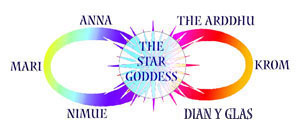
The Twins
The concept of the Divine Twins as consorts to the Star Goddess was very important to Victor, and much of the confusion about the relationships among the Feri deities is due to the attempt to superimpose a system based on the triple goddess twinned with a triple god (the lemniscate) upon the twin nature of each of the deities. So we have simultaneous descriptions of Krom, for example, being twinned with his opposite number on the lemniscate, Mari, and also being a set of twins himself, the Red God of the animal kingdom and the Green God of the vegetal. Both are simultaneously true, which yet another example of Feri paradox.
Placement on the lemniscate is not precise, either. Some would separate the Dian y Glas from Melek Taus, even though many Feris conflate the two; Melek and his twin Lemba can be placed on the lemniscate somewhere between the youthful Dian y Glas and the full-grown, adamantly masculine Krom (who Victor declared "is the same person as the Holy Goddess herself.") Each lobe of the lemniscate is actually a full life-cycle, from birth through maturity to old age and death, and an infinity of gods and goddesses can be placed along these paths. Willow told me that the Nimue/Mari/Anna and Dian y Glas/Krom/Arddhu points are convenient "stopping places" at which we can see the characteristics of the deity full-blown.
In her book, Fifty Years in the Feri Tradition, Cora says: "In most traditions of the present time the Goddess is pictured as having one single consort. In what is now called Fairy Tradition She is known to have two consorts. These divine Twins are exactly alike and can function as a pair or both at once. They are both Her son and lover.... We could put it this way and say the bright and dark Godhood are the two sides of a chess board with the Divine Twins at play while Mother makes the rules."
The Blue God/Melek Taus/Dian y Glas
The firstborn of the goddess is the Blue God, also known as the Peacock Angel, Lord of the Painted Fan, and by some as Melek Taus. The Blue God is regarded by some lines of Feri as the particular patron deity of Feri. The Dian y Glas is usually pictured as a young, blue-skinned, ithyphallic, yet somewhat androgynous god with a serpent. A beautiful picture of the Blue God can be found at Storm Faerywolf's website at http://www.faerywolf.com/art_presencebluegod.htm
As Melek Taus, the Blue God is the twin of Lemba, the Lord of the Green Flame, also known as the Living Serpent. He is the main deity of the Yezidi people; an excellent picture of him by Paul Rucker can be found at http://www.ziarah.net/melek.jpg. Comparing Storm Faerywolf's picture of the Dian y Glas with the Rucker picture of Melek Taus will give some idea of the difference between the two which words are inadequate to describe. There is a wealth of information about Melek online, including:
http://www.semjaaza.com/azazel.html
http://echoes.devin.com/watchers/melek.html
http://www.semjaaza.com/peacock.html
[update 02/01/06... I'd love it if you included the detail of Krishna (in his baby/flute-playing boy sense) also being very much Dian Y Glas:). He's decorated with peacock feathers and this particular practitioner (amongst several others) finds him her favourite depiction of the young Blue God:).
--Snowgrouse(:>) (Feri student), 02/01/06 ]
How's Lucifer connected to the Blue God? What's the meaning of Lucifer in Feri tradition?
By happydog, via email:
The connection with Lucifer and Melek Taus (who some see as the Blue God of Feri, others not) seems to come from western views of Yezidism, which identifies Melek Taus with Lucifer, according to alleged versions of the Yezidis' holy texts, "Mishaf Resh" and "Al Yalvah." The following link leads to one partial rendition of these texts:
http://www.angelfire.com/md3/thelema/texts/vasti.html [update 02/01/06:This link is dead. try http://home.c2i.net/blinge/Essays/mishaf.html]
However, English translations of both the "Mishaf Resh" and the "Al Yalvah" (also known as the Kitab al-Jilwah) are reportedly viewed with some dismay by modern Yezidi groups. According to various authorities, these texts are regarded as at worst fiction, and at best compilations of certain aspects of Yezidi belief, some accurate and some not. These alleged holy texts may or may not also be influenced by Islamic views of Yezidism...The above link is a transcription of a book from the late 1800's, and the translation is of suspicious authority; I offer it for reference *ONLY.*
Anton Szandor LaVey had no compunction about identifying Melek Taus with Lucifer/Satan, and in his "The Satanic Rituals" there is a chapter on an alleged Yezidi homage to Satan, which has been called an outright fraud in scholarly articles in Denge Ezidyan, the official (German language only, unfortunately) publication of the Yezidi religion. However, LaVey's depiction of Yezidism as Satan worship (therefore Luciferian in his view) has made the rounds and been highly accepted in some circles, especially in the "left-hand-path" groups.
It is also true that the Islamic peoples of the region are openly hostile toward the Yezidis, to the extent of persecuting them in some cases. Some of their hostility has taken the form of denigrating their religion by referring to Melek Taus as "Shaitan," or Satan, which is a forbidden word among the Yezidi. I am not sure, from my research, if the word is forbidden because it is sacred, or if it is forbidden because it is an insult to Melek Taus to compare MT to Satan. Sources have it both ways.
The identification of Melek Taus with Lucifer is also questionable, because that identification is drawn from texts of the 1800's, when the Yezidis were first discovered by Western travelers. Their view was that MT = Lucifer = Satan, which may not be the case.
Most Western travelers in the Middle East in that period were there either as missionaries or as agents of the British Empire, and both were emphatically and explicitly Christian. As a result they were trying to convert the Yezidis to Christianity, and so it would be to their benefit to portray Melek Taus as Lucifer/Devil/Satan.
Complicating things here is the fact that Yezidism is an orally-transmitted, highly mystical religion and has been a "minority religion" in some of the least-travelled and least-understood regions of the Middle East for quite some time.
As a result there is a great deal of misinformation floating around about the Yezidis. For example, one recent online source states that "Yezidis are not reluctant to proselytize," and that they accept converts. However, in a news article I have read, the reporter interviewed a Yezidi religious teacher who stated definitively that the Yezidi do NOT proselytize and do NOT accept converts. Add this to the fact that there are separate sects within Yezidism itself and it makes misinformation a surety...
So it seems, at least to me, that the identification of Melek Taus with Lucifer is questionable. I'm not saying that it's invalid, I am simply saying that there is some question, from the research that I have done, whether or not identifying Melek Taus with Lucifer and/or Satan is accurate according to Yezidi teachings. --happydog
Nimue
source: FRW
source: TJ/WM, phone conversation
Nimue: Also known as the Kymari or the Sun Maiden, she is the Maiden aspect of the Triple Goddess. The Faery Roads website says: "because of her youth, she is somewhat androgynous. Nonetheless, she still embodies the energy which brings all into being, which in humans is sexual energy, a great Passion. Imagine all the power of the Cosmos in the hands of a six-year-old..."
Victor regarded Nimue as the Black Heart of Innocence incarnate. As the prepubescent girl, first emanation of the Star Goddess (cf. Starhawk's creation story), Nimue is the Holy Child, embodiment of forbidden passion. She is the protectress and avenger of abused and mistreated children everywhere, fierce, wild, and innocent. Her priestesses wore two green snakes in their hair, and she was accorded a sacrifice of four red pigs, four white pigs, and one black pig, showing her connection to the love and death aspects of the Star Goddess.
Krom
source: FRW
Also known as Cernunnos, he is the Horned God with whom Witches in general are familiar. "The Harvest Lord: He is the Spirit of Light and Heat, the ripeness of Summer, and the fullness of Manhood. There is nothing androgynous about him. He is often considered the consort of and parallel of the goddess Mari. At the same time, He, too, is a reflection in a dark mirror of the Star Goddess." --Faery Roads
Mari
source: TJ article
The Mother aspect of the Triple Goddess, and the closest form to the Goddess familiar to mainstream Wicca, who mates with /mothers/slays the familiar Horned God. A reflection/ subdivision of the Star Goddess, she can further subdivide into different aspects: "Each of these primary deities show different aspects to the devotee at different times, for example the fecund Green Mari or the fierce protectress Red Mari, etc." --Niklas Gander
The Arddhu
source: Victor Anderson, quoted by TJ/WM
The Winter King: the male (though somewhat androgynous due to his age) crone aspect of the God. The Arddhu (pronounced "ar-thee", Old Welsh for "the Dark One," also sometimes spelled Atho) is the Opener of the Gates of Life and Death, and thus is not to be invoked lightly. The Arddhu and the Ana are the "natural gods of nature" according to Victor.
Anna/The Ana
source: FRW
The Crone. "She represents old age or death, winter, the end of all things, the waning moon, post-menstrual phases of women's lives. All destruction that precedes regeneration through her cauldron of rebirth. Also known as: Anu, Ana, Annys, Anysa (Celtic), Black Ana of the Forbidden Mysteries, Cerridwen (Welsh), Arianrhod of the Silver Wheel (Welsh), the Morrigu (Irish), Kali (Hindu)".
source: The Ancient British Goddess,
http://www.kathyjones.co.uk/local/hpages/kathyj/apbritgoddess.html
"The next great recorded arrival in the British Isles was that of the Tuatha de Danann or the People of the Goddess Dana, Danu, Anu, Anu Dana, Ana or Amma. She is the first of the three Fates, a Goddess of Rebirth. She is the Mother of all the Gods and some say She is also Domnu, the Goddess of the Fomoire. Near Killarney two mountains are still called the 'Paps' (breasts) or 'Paps of Anu'. Her people were said to have arrived from the sky, landing on a mountain in Ireland.
Danu was masculinized in later Welsh myth to become Don and the stories of the Tuatha de Danann are equated with the People of the Don in the parallel Welsh mythological cycle of the Mabinogion. In Saxon tales Anu became Black Annis. She was also Ana Our Mother, Morg-Ana the Virgin/Crone and Anna the Grand Mother Goddess." Anna is the Cailleach, the Crone who becomes the Maiden once more at Imbolc, completing the cycle of the year.
[update 02/01/06: The preceding link is dead. For online info on the Ana or Anna, try http://www.spinninglobe.net/goddessnames.htm
...Cohane believes Ana to be primarily the personification of an abstract quality -- "blessed" from the Semitic tongue - and sees the distribution of place-names with the "Ana" element in them primarily as designations for "Blessed Awa." Robert Graves says the name means "queen."
According to Barbara Walker, editor of The Woman's Encyclopedia of Myths and Secrets, the name appears in a great many cultures, some widely separated by time and/or space. Thus, there is Anna-Nin, Nana or Inanna, Queen of Heaven in Sumeria (An means Heaven in Sumerian, according to Graves), Anatha, (Syria), Anat (Canaan), Ana or Anah (Old Testament), Di-Ana (Semitic) or Dinah (from the Syriac version of the Old Testament, referring to the goddess of the Dinaite tribes in Sumeria), both uses of "Di" referring to divinity or godhead, Anna (Pelasgian Greek), Nanna (the incarnation of the Danish Goddess Freya as the mother-bride of Baldur), Anu (early Danaan Goddess in Ireland), Ana or Anan, which Robert Graves says are names for the Goddess Danu, who had two aspects, one nurturant, the other maleficent, as which she was sometimes known as Morg-ana to the Irish ("Death Ana," one third of the triple Goddess known as The Morrigan, ("Great Queen"); Anna Perenna (Roman), Black Annis of Leicester to medieval Christians, who lived on "Dane Hill" (Danaan?) and used to devour children -- ending with St. Anne, mother of the virgin Mary, grandmother of God. This long history seems to me too ubiquitous to be reduced to an abstraction! It goes even further: Graves cites the view of a Mr. E.M. Parr that Athene was another Anna namely, Ath-enna, which occurs in inverted form in Libya as Anatha. Graves' verdict on the subject is "...if one needs a single, simple, inclusive name for the Great Goddess, Anna is the best choice."...
Upcoming soon: my page on Anat/Tanit/Neith (currently in work). Apparently Anatha, as she is known in the Feri Candle chant, is another of those Great Goddesses once known in triple aspect as Maiden-Mother-Crone but subsequently relegated to strictly Crone status. Hekate underwent a similar process.
-- vw]
The Guardians
source: TJ
source: FRW
The Guardians, also known as the Nephilim, the Watchtowers, the Korylan, or the Grigori, are not so much deities as they are segments of the universe which might include deities. They exist at one and the same time here on earth at the periphery of the circle, and in the vast depths of space. To call them "means to focus their energies in a particular place."--Niklas Gander
The attribution of the elements and ritual tools to each direction is a subject of much discussion. The consensus is that the elements take the directions which seem right depending on where you are. Thus in California, Water would rightly be in the West, and Fire in the South. On the East coast, Water would more correctly be in the East. Not to mention the total reversals required in the southern hemisphere! (There is an interesting article on directional attributions by a Welsh Traditionalist, Mike Nichols, who gives reasons for putting Air in the North, at http://www.geocities.com/Athens/Forum/7280/rethink.html). Feri tools are generally held to be Wand for Air and Knife for Fire, which is the reverse of the way many people are used to regarding them. The slight disconnect involved in using an unfamiliar attribution is interesting and probably salutary.
The English names of the Guardians are:
Air: Star Finder, who represents the power of Knowledge.
Fire: Shining Flame, who represents the power of Truth.
Water: Water Maker, who represents the power of Love.
Earth: Black Mother, who represents the power of Wisdom.
The Guardian of the Zenith (above) is Heaven Shiner, The Guardian of the Nadir (below) is Fire in the Earth, and they represent the power of Pure Consciousness.
The Guardian of the Center is regarded by Reclaiming as the same as the Guardian of the Gates, but by other Feri lines as the Witch Hirself.
The Guardian of the Gates is called when invoking the Mighty Dead.
The preceding are now regarded as more-or-less public names; this was not always so. Eldri Littlewolf tells me that these names were kept quite secret in the early days of Feri, as was the Iron Pentacle.
Other deities:
The Elemental Goddesses: (These are regarded as the feminine aspect of each Guardian.)
sources: Spiral Dance/FRW/WM and websites indicated
East: Arida
http://www.geocities.com/Athens/Rhodes/5569/FaeDirectionGoddesses.html gives the name of the Eastern elemental goddess as Arida, which is also found in Starhawk's The Spiral Dance.
http://www.dame-mehri.com/lorraine/fullmoon-99.htm gives this version of the name as one of the names of the full moon and also invokes her for air. It was also a secret Gardnerian name for the Great Godddess.
This name closely resembles "Aradia," familiar as the title of Charles Leland's 1899 work, subtitled The Gospel of the Witches. Leland claims this to be a true account of nineteenth-century Italian witchery, aka Stregheria or La Veccia Religione (online at http://www.sacred-texts.com/pag/aradia/index.htm.) Aradia is the daughter of the goddess Diana by her brother Lucifer, who she seduced in the form of a black cat. Doreen Valiente says about variants on this name in Where Witchcraft Lives, "The Italian Aradia is evidently Herodias, and an Italian writer Pipernus writing about the witch cult in 1647 conjectured that the name did not refer to the character in the New Testament, but was much older. The nineteenth-century American folklorist Charles Godfrey Leland agreed with this, and states his belief that the name Herodias was originally a title of Lilith, the weird Sumerian goddess of witchcraft and the Other World."
South: Tana, Tanit[h]/Anat[ha]
source: Serpent of Wisdom, http://www.songsouponsea.com/Promenade/IslandsE.html#Tanit
Source: http://wald.heim.at/sherwood/530383/anat.html
"The Sumerian word for god is dingir, which became tengir, then tani. Tan means serpent. Asherah was also identified with the Sumerian goddess Inanna and the Babylonian Ishtar, whose symbol was the eight-pointed star and crescent preserved by the Sumerians as an old shamanistic symbol for the godhead. Ishtar became Astarte to the Semitic Phoenicians, and later Tanith, the serpent goddess.
As Tanith, Asherah's symbolic pole was represented as a pole with two serpents twisted around it (the caduceus). In the Garden of Asherah, the Serpent of Wisdom taught men how to become immortal like the gods (Aleim, one of the Children of the Gods, which the Jews wrote as Elohim)."
According to Leland's Aradia, Tana was the old Etruscan name for Diana, which is still preserved in the Romagna Toscana. The "Anat" form of this name was fused linguistically with those of Astarte, Isis, Neith, and several other goddesses in ancient Egypt. According to Raphael Patai's The Hebrew Goddess, Anath was an importation from the Canaanites who was worshiped by the Jews in early times. Curiously enough, the version "Anatanta" was found at at Tanis in Egypt, during the period of Ramses II.
West: Tiamat
Tiamat is the well-known Babylonian deep-sea serpent mother goddess thought to be the daughter of Chaos. According to the Enuma Elish (c. 2000 BCE), Marduk slew the sea goddess and cut her body in two. With one half he formed the sky, and with the other he formed the earth. For more info on the Enuma Elish, see http://www.theologywebsite.com/etext/enuma/eintro.shtml.
North: Belili/ Verr-Avna
source: Lunar Cycles and Goddess Energies, http://homestar.org/bryannan/moons.html
Sumerian White Goddess. Beli "white," bellus "beautiful," bile "sacred tree." Originally, every tree was hers, but above all she was known as a willow goddess, and also of wells, springs, love, and the underworld. She was the predecessor of Ishtar, and the sister/lover of Tammuz. She was later transmuted into Beli/Zeus/Jupiter, the "supreme god of light," who became known as the "father" to Arianrhod and all goddesses.
I have been unable to find any references to Verr-Avna (but see Tony Spurlock's explanation below.)
More (and more accurate) Info on the Directional Goddesses:
From the Witch Eye e-list:
Date: Thu, 03 Feb 2005 15:28:49 -0800
From: "Dragon Morn, Rex Pictorum"[Tony Spurlock]
Subject: Re: Goddesses of the Directions
By way of warning, let me say that I'm going to proceed as if thesethings can be discussed openly. I see no point in trying to delicately edge around these Goddess names just on the possibility that some ... might not be familiar with them. Therefore, I'll just run down my "take" on these names and the whole institution of these names, that is, their place in Feri praxis as I see it.
Firstly, -- and I certainly don't mean to offend anyone by this assessment -- these names and their use have been a small thing, used only during the initiation. And, I think, it was just a "Victor-ism". While it's always possible that they did this in the Harpy Coven, I think it was added by Victor at a later time. I'm one of the few people who has any particular qualification to speak on this, in that I am the person who rendered the "cassette of initiation" into a written form. It is my rendition that forms the basis of most Feri initiation texts.
It was in 1977, not long after my own initiation, while I was living at Caradoc's (Gabriel's) house in Berkeley, that Caradoc and Steven (Hewell) succeeded in convincing Victor to put down everything he could think of about the initiation onto audio cassette. This resulted in a lengthy tape, I think 90 minutes. As you can imagine, Victor alone with a microphone and a 90 minute tape resulted in a meandering exposition that went in and out of focus. At certain places Victor would imagine himself in the midst of the ritual, giving imagined improptu "lessons" or instruction to the imaginary initiate. Since I had recently been initiated and since I was a scholar of Wicca (I had been able to recite a standard Wicca initiation from memory for years), I was eagerly and minutely studying the tape as soon as it came into the house, and therefore it fell to me to transform the meandering tape into a written initiation ceremony.
As is typical of this sort of ceremony, after the 'crisis' of the Oaths and, in our case, the sequence that culminates in the passing of the Names of the Goddess and God, there is presentation of the new brother or sister to the four directions. But, because Feri has special names and signs for the Lords of the Outer Spaces, this first circumambulation becomes an extension of the passing of the Names: the inititiate is still being given revelation of secret information. And, because this first circuit is instructional (being shown how to make the Signs, etc.), Victor felt the "proclamation" or "presentation" of the new initiate to the four corners of the world had yet to take place. Therefore he immediately adds a second circuit for the Presentation.
Now, in Gardnerian type initiations, this presentation would be to unnamed guardians, spirits, or Lords of the Watchtowers of the directions. Well, having just spent so much time teaching about our own peculiarly Feri Lords of the Outer Spaces, such a presentation would be redundant and a cause of confusion as regards the zenith and nadir. Hence the source of Victor's solution: Goddess names for the four directions/elements, to be used in the Presentation of the new brother/sister of the Craft; also serving to remind the initiate that this is a Goddess-worshipping cult, a subject that hadn't been addressed for the last many minutes of the ceremony.
Arida: East/Air -- Why this name for Air? Although I risk sounding silly, I should point out that the first three letters of this name are exactly those used to spell A-I-R, which would not be true if the name Aradia were used. Moving to the named Aradia, however, I think I see a more satisfying clue. Most people, misguided by the the utterly irrelevant Biblical namesake mother of Salome, aren't aware that Aradia is just Leland's prefered ALTERNATE SPELLING of Herodias, the Italians (like the French) prefering not to pronounce initial 'h' or final 's'.
Why should that be important to the present discussion? Because -- Salome's mother being irrelevant -- what is the single most important connection between Herodias and Witchcraft? It is that early Catholic Church document denouncing those women, deluded by Satan, who claim to FLY THROUGH THE AIR with Herodias!
Tana: South/Fire -- ... I'm unfamiliar with the legend of Tana that connects her with fire. But the 'accident' of her name punning with the Celtic words for fire is a happy one. If my guess that Tana is Etruscan is right, maybe it is more than an accident of language. This reminds me of my researches into "Saint Kentigern" as a Pictish remnant of the cult of Lugh in North Britain. Kentigern's earliest miracles are all concerned with lightning and fire and his mother's name is Thaney or Teniu or Tanuuetis, which name I suspect of being based on Tan/Fire.
Heva Leviathan Tiamat: West/Water -- Contrary to what some webpages say, the original tape had Victor saying this name as three. This is typical of Victor's phase of studying Mesopotamian mythology and the Pagan roots of the Bible (see also the Goddess Candle-lighting chant). Tiamat was the primordial sea serpent of Sumer/Babylon's creation myth. She was chaos and filled the pre-creation limitless sea of space. From the remains of her carcass, all the rest of the universe was made, reminiscent of Ymir, the Norse Frost Giant. Because of Victor's fascination with astrophysics, he could expand at length on how this original mother serpent resembles the pre-Big Bang universe. Leviathan (which he pronounced with all short vowels, stress on the first syllable. Thus: LEVee-ahthahn) is an Old Testament gigantic sea serpent, as well. In Antiquity, it was widely thought that all solid land was clumped toward the center of an enormous great sea that encompassed everything. This sea was, in turn, personified by the idea of an immense serpent that filled it, sometimes called the World Serpent. HEVA is just a rendering of the Genesis spelling of the mother of mankind, EVE. The definite article is indicated by an attached 'h'. They did likewise with Adam, yielding The Adam and The Eve: H-adam and H-eva. Heva also being Hebrew for 'womb.' (H-adam is understood as meaning The Red, as in the color of clay.) Thus, for West, Victor is saying "The great sea-serpent womb of the sea, our mother." Heva Leviathan Tiamat.
Verr-Avna: North/Earth -- Corresponding to and resembling no name I can think of (nor Google), I think Victor got this name from his astral travel, which he ardently practiced and from which I think many of his more astonishing flat statements derived (though he usually referred to these as past life memories). He probably was taught this name by the Goddess, or some goddess, perhaps Verr-Avna. It is likely that he considered it to be in the language of the small dark folk. Regarding the complex called North/Earth in esoteric Witchcraft, Victor was perfectly aware that in the ancient world-conception Earth, as well as the Sea, equates with infinity. That is why he also linked the North with the Well of Space when treating of the Lords of the Outer Spaces. The Earth, or the esoteric Earth, is infinite and black, like space, because not only is unexplored wilderness (which is in the North) infinite, but because we magaically travel underground/under Earth, and that is a limitless expanse.
The Seventy-Two Bright Spirits: also known as the Shem-Ham-Forasch. Seventy-two is a magickal number in many traditions, being the number of the so-called "Genii" of the Mercury sphere. These beings are known in the original Hebrew Kabbalah as the 72 Genii or "Names of God" or as the 72 lettered Name of God. For much more on this, see Franz Bardon's online book "Buchman-Naga: Talismanic Theomagic" at http://www.geocities.com/franzbardon/buchnaga_e.html; Dr. Joshua DavidStone's lists of the 72 names at http://www.drjoshuadavidstone.com/compilednames.htm and Jim Cornwell's excerpt from his The Alpha and the Omega at http://www.mazzaroth.com/Introduction/TheNamesOfGod.htm
Other deities common to Feri and other traditions include Hekate, Cerridwen, Kali, and many others, depending on the devotional practices and preferences of the individual. One's personal deity is the deity that the individual practitioner feels most drawn to contact/ pray to/ interact with/ aspect as part of Godself, the interface between the human and the divine. In some other occult traditions this is known as the Holy Guardian Angel.
Goddesses and Gods of the Candle Chants:The candle chant is used in some lines as an invocation when the candle for the Star Goddess is lit during the casting of a Feri circle (actually, a sphere): "Ashtaroth, Ashtoreth, Belili, Belkoreth, Lilith-Alure, Anatha, Tiamat!" These names have been explained to me as corresponding to the concepts of Fertility, Beauty, Power, Darkness, Above/Below, and the Ultimate. There is a corresponding chant for the god which goes: "Keraillos, Keranos, Kernunnos, Krana, Kronos" and which apparently is composed of titles of the God in different stages of his life-cycle. Not all lines use these candle chants.
Patai explains Ashtaroth as being the plural form of Ashtoreth, which was the Hebrew version of Astarte. For Anatha and Tiamat, see notes on the directional goddesses, above. The "Alure" title of Lilith-Alure is unexplained, and may be another Victorism.
What are the basic Feri practices? [Update 02/03/06]
[Versions of some of the core practices of Feri are located on this site. Click HERE for more info. - Storm]
Some specifically Feri tools used to accomplish self-development work are: [VeeDub's material, offsite links]
a.) Alignment of the Three Souls
b.) The Pentacles
c.) Elemental Balancing
d.) Energy Work (Blue Fire in some lines)
e.) Kala Rite
f.) Deity work
g.) Shadow Lover/Frevachi (Demon work in some lines, not used in all lines)
[Note: links are to my own open-source Compost Tradition practice and may not correspond at all with the praxtices of other lines of Feri.]
The Three Souls
source: Thorn Coyle's website at http://www.thorncoyle.com/
source: PW, email, SF, personal conversations
| Soul |
Color |
Position |
Hawaiian name |
Hebrew name |
Egyptian name |
African name |
Fetch,
ChildSelf |
red(VA) |
Pelvis |
Unihipili |
Nefesh |
Ka |
Vivi |
| Talker |
yellow(VA) |
Chest |
Uhane |
Ruach |
Ba |
Emi |
| Godself |
blue(VA) |
Skull |
Aumakua |
Neshana |
Za |
Ori |
We are a trinity. We have a soul that stores the life-force and speaks in symbols and through play. We have a soul that communicates through speech and listening, through words and energy. We have a soul that is Divine, that is ancestor and teacher.--Thorn Coyle
In Feri, each of the three souls is thought to use a different type of energy. (This is pretty much identical to traditional Huna teachings.) The Fetch/Unihipili uses a basic form of energy called mana. In Sanskrit this energy is referred to as prana, in Chinese it's called chi. Both Feri and Huna agree that mana is the fundamental energy of life present in everything. Our Fetch gathers mana from food, air, etc. to create and maintain our material existence. The Talker/Uhane amplifies mana into mana-mana. Mana-mana is used to create and maintain our conscious thought and ability to reason. The God-Self/ Aumakua uses an exponentially more powerful form of energy known as mana-loa. Through practices like the Ha Prayer, we can gather up and send mana to our God-Self through the Fetch. The God-Self then converts it into mana-loa and uses it to create/heal/etc. on our behalf. In Huna it is said that the kahunas could instantly heal major injuries and perform other miraculous feats through the power of mana-loa. --Phoenix Willow
The Pentacles of Feri: are a set of meditational devices which are characteristic of, but not exclusively confined to, Feri. All pentacles below are listed in order deosil from the top around the points, though they can all be worked through the pentacle (i.e., Sex, Pride, Self, Power, Passion for the IP). There are many different ways of running the Pentacles. Starhawk taught the roundways method, but many Feris use the throughway method primarily.
Some good links to further study include: http://www.faerywolf.com/essay_ironpentacle.htm, an article by Storm Faerywolf
http://www.reclaiming.org/newsletter/67/pentacle.html The Iron Pentacle as a meditative tool, by Hilary Valentine of Reclaiming
http://www.tejasweb.org/html/writings/epistepentacle.html Epistemology and the Pentacles of Feri, an article by Mike Rock
Iron
| Sex |
Self |
Passion |
Pride |
Power |
(Some Feri practitioners use the Iron Pentacle with the Self and Passion points at the practitioner's right and the Power and Pride points at the left; others reverse this with Power/Pride at the right and Self/Passion at the left.)
Pearl
| Love |
Knowledge |
Wisdom |
Law |
Liberty |
(There is some disagreement about the position and naming of several of the Pearl Pentacle points. Some Feri place Wisdom at the left hand and Knowledge at the left foot; and some place Power rather than Liberty at the right hand.)
Other Pentacles (see footnotes for sources):
| Elemental 1 |
Ether |
Air |
Fire |
Water |
Earth |
| Lead (Bloodrose)2 |
Greed/Lust |
Egotism |
Obsession |
Arrogance |
Force |
| Lead (Victor)3 |
Discernment |
Realization |
Control |
Density |
Stability |
| Life |
Birth |
Initiation |
Ripening |
Reflection |
Death |
| Rust |
Self-abnegation |
Indifference |
Ignorance |
Guilt |
Sloth |
| Chivalric4 |
Generosity |
Courtesy |
Chastity |
Chivalry |
Piety |
| Dance of Shiva5 |
Creation |
Veiling |
Manifestation |
Destruction |
Release |
| Tuatha6 |
Poetry |
Music |
Dance |
Healing |
Agriculture |
| Underworld7 |
Opening |
Judgement |
Rebirth |
Letting Go |
Death |
| Magus8 |
To Weave |
To Dare |
To Will |
To Keep Silence |
To Know |
Notes:
1. There is a great deal of variation in the attribution of elements to pentacle points. The Bloodrose-derived lines follow Gabriel's lead in attributing the element of Water to the Passion point and Fire to the Pride point on the Iron Pentacle. Victor, however did not attribute elements to the pentacles or to the tools.
2. and 3.: Gabriel's version of the Lead Pentacle is for dealing with imbalances, while Victor's Lead Pentacle is for manifesting and healing.
4. According to Macha NightMare, this is the set of qualities which Sir Gawain had on his (pentacle) shield, and which are the qualities of the true knight.
5. email communication from Reya Mellicker.
6., 7., 8. From the Pagan Universalist site at http://members.tripod.com/~kalimountain/pentacle.html
There are many more Pentacles. One interesting one is the Amethyst Pentacle by Storm Faerywolf and Chas Bogan, which appears in Witch Eye #7. This also names the paths between the points as well as the points.
Energy Work
source: PW, email
About the use of Blue Fire in Feri.
Many years ago, Gabriel introduced a series of exercises for working with "Blue Fire" into Feri. These exercises were based on prana yoga techniques. This form of Blue Fire is synonymous with mana. So when someone of Bloodrose-derived lineage talks about "Blue Fire," they are usually referring to prana/mana/chi. The same is true of Reclaiming, as many Reclaiming folks have trained off-and-on in Bloodrose-derived Feri. These groups have many excellent exercises for perceiving and working with this energy.
Victor, however, used the term "Blue Fire" to refer to mana-loa, the "fire of the gods." This is how the term is used in Cora's book (Fifty Years in the Feri Tradition, pages 39- 40). The Bloodrose lineages usually recognize a mana-loa type of energy as well, but refer to it as "White Fire" or sometimes "Baraka"--an Arabic term of roughly similar meaning to mana-loa. (There may be other terms in use as well.) --Phoenix Willow
There are many ways of raising energy; some specifically Feri methods are the Ka-Ba-Za meditation of Nighthares and the Ladder of Hestia in my own practice, in both of which the energy of each soul is envisioned while chanting; the Ha Prayer, which sends energy to the Godself by way of the Fetch; energy purifications such as the Kala rite, and others. The Pentacles are another category of energy work.
The Kala Rite
This is a method using a cup of water for purifying energy and reclaiming bound-up life force. Kala is Hawaiian for "to loosen, untie, free; to forgive, pardon, excuse; to proclaim," and to be kala is to be pure, clean, focused, and clear in intent.
The Shadow Lover/Frevachi/Demon work
Not all lines of Feri practice demon work or frevachi. The concept was originated by Gabriel Carrillo, and his descendants have become accustomed to using several varieties of work with one's personal demons or with actual demonic spirits. Rhea Shemazi has an excellent article on the subject in Witch Eye #5. The Feri "toolbox" contains a number of techniques excellent for dealing with core personal issues, or "complexes," as Victor used to call them.
Why does the training involve secrets and oaths?
source: CA
Some of the secrets are unbreakable because they involve concepts and experiences which are not expressible in words. A few are secret because Feri is a mystery religion, and publishing them would destroy the mystery.
Remarkably little is actually oathbound material, according to Cora Anderson: the Names of the Feri deities and Guardians, and the inexpressible current of energy which is passed from teacher to student at initiation. However, there has been a tendency in recent years to regard more and more information as oathbound, at least in some lines. And some material which was formerly quite secret, such as the Iron Pentacle, is widely disseminated these days. Initiatory oaths are optional, according to Cora Anderson. At the same time, she says that initiation like getting married to the gods -- there's no taking it back. Once a Feri initiate, always a Feri.
For more of Cora's comments on this, see the question on GrandMastership below.
What does it take to be a Feri?
source: Thorn Coyle's website
-- Black Heart of Innocence: "the innocent, sexual state found in the child before her force was constrained and perverted, and in the animal still roaming in the wild"--Thorn Coyle.
-- Warrior ethic: since Feris do not subscribe to the Wiccan Rede, they each have to work out a code of ethics for themselves, one which takes personal responsibility for every act and judges what is correct action by each situation individually. A lot of discipline is necessary in order to overcome the temptation to regard one's wants and needs as paramount, superceding those of anyone else.
-- Ability to face one's own personal demons and come to terms with them
-- Ability to "cross over" into the Faerie realm
-- Ability to work with the Feri "current"
-- Psychological strength and flexibility
-- Initiation by a Feri initiate during which the Mysteries are passed
-- Ability to develop actual personal relationships with the Gods, up to and
occasionally including actual possession -- Courage enough to go into the wild places of the heart
What is a Grandmaster? Who can be a Grandmaster?
source: CA, Tests of a GrandMaster
Cora Anderson, GrandMaster since Victor's death, stated the qualifications for Grandmastership thus: Once an individual is brought into the Craft no mortal may take that individual out. When an individual strays he must be brought gently back into the fold. An initiation cannot be undone as it would be like divorcing oneself from the Gods, and that is ridiculous. A disharmonious individual must be dealt with as best as possible.
In the very beginning of our practice in the Craft, there were very few individuals involved. Yet arguments and dissension among us soon broke out. Victor created the GrandMaster position to settle important matters and maintain harmony within the circle. The power of the GrandMaster is great, so is the responsibility. One must prove these tests first and let their actions through time be the final judge. There can be more than one GM, but it is not appropriate for every coven to have their own. I pass on the tests and requirements for Grand Mastership. As can beseen, these requirements are very difficult, as they should be.
1. One must be an initiate for at least two years.
2. One must have command of the Black Wand by demonstrating mastery in the techniques of magic. Possession of the black wand does not make one a GM. It signifies a Master who possesses all the powers of sorcery and mastery in magic.
3. One must demonstrate astral travel. The candidate must be able to enter a circle and observe, keeping the rest of the circle unaware. Permission from the HP should be given before any such test and an open circle should be chosen for the test site. The HP gives a sign, significant enough to be seen, yet subtle so as not to break the normal workings of a circle. The candidate must be able to relate this sign to the circle.
4. One must be able to define the duties of a GrandMaster.
5. One must possess the Black Heart of Innocence.
6. One must have seeded at least six covens.
7. One must be trained in possession.
On August 23, 2003, a new Black Wand/Grandmaster, Anaar, was inducted by Cora Anderson in the presence of a few Feris. This is Anaar's message to the Feri community:
It is my reluctant duty to inform the Feri community that Cora Anderson has given me the rite of passage into the Grandmastership. I use the term "reluctant", for I am feeling reluctant, but this occasion is not without some pleasure. I am proud that Cora has such faith in my abilities, it is an achievement of a lifetime. I can only hope and do fervently pray that I am able to live up to the Andersons' expectations. I am grateful to my friends for their continuing support.
There are many misconceptions about the Grandmastership which I would like to clear up. These misconceptions have led many highly trained priests to give up their personal power. Once it is given, it is far too painful and horrifying to retrieve it. I do not and will not accept this. There is no priestly hierarchy in Feri, and the Grandmaster holds no greater importance than any other respected priest and elder. Here are the duties of the Grandmaster:
to oversee the covens,
to act as a mediator and settle tradition related disputes within a coven, and between covens
to be a keeper of Feri lore and secrets,
the Grandmaster cannot put anyone out of a coven,
the Grandmaster cannot undo an initiation,
the Grandmaster cannot break a coven or cause it to break.
The only right and privilege of the Grandmaster is that I am free to visit any coven in the astral, not as a participant but as an observer so that I may learn. Needless to say, this experiment will never be undertaken without the express permission of the entire coven.
Many honorable members of the community have pressed me to join one of the many Feri lists available in order to fulfill my duties; however, I must decline. I find these lists to be toxic to my serenity and am therefore disinterested. Should a conflict arise concerning Feri principles (and not Feri personalities) it is my duty to mediate. I do say "mediate" and not "dictate." However, the principles were set down long ago, at the dawn of man's consciousness, and I trust that I have received them well. Despite our tradition of creativity (and on this point I must be clear, creativity is inherent in Feri) these ancient core principles leave little room for deviation. I am by nature a somewhat private person, but I remain open to honest seekers of the faith. To that end, I may be indirectly reached through my closest friends, or directly through my web site. Please be careful in the subject heading, if I do not recognize your address I will not even open the file. I ask all who know how to reach me to understand my position and not give out my personal information. Nothing pains me more than the realization that this may cause some rift and indignation in the community.
This is a large undertaking and I need some time to adjust. I am reminded that I am still Cora's student. Given time, my feelings regarding my private nature may change. I am leaving for Hawaii and will return the 6th of September. Hawaii will give me the space and time to meditate on this matter.
Thank you for your understanding and thanks to those who support my decision. Evohe! Blessed Be.
--Anaar
What is the wand system?
source: SF, email
source: CA, personal conversations
The wand system is a series of three grades: the white wand is granted at first initiation (in some lines, on first meeting), the green after mastery of Feri lore and practice (in some lines, at or just before initiation), and the black wand on being recognized a true master of magick. Not all lines use the wand system. The Black Lotus line has a different arrangement of wands and different meanings for each:
Victor taught some of his initiates in Black Lotus and Nostos covens a slight variation on the wands. He gave the order as green first, and then white, and finally black, and this is what we currently practice: Green for new, growing things; white for the flowering or blooming stage; and black for true power and wisdom that comes with maturity. In addition, the different wands represent specialities. Green Wands, V taught Black Lotus, are healers and herbalists. White Wands are poets and artist Witches. The Black Wand for Feri elders trained in powerful sorcery: e.g. conscious astral travel, possession by the lwa, and the death prayer.--Soul Fire
Cora explains the purpose of the black wand as being somewhat akin to the institution of the Talking Stick. The wand-holder would raise it aloft, and nobody could speak, thus stopping disputes in their tracks and enforcing silence. The green wand could do this in hir own coven; the black wand had the authority to do this in a gathering of several covens.



